All of us who love gardening in Florida appreciate the plants with blue flowers and the serenity they bring to our tropical gardens. And here is how to add the blue flowers. But it is also true that the flower that blooms in blue is a mystery to us all! This is because there is no blue pigment in any plant anywhere. There is no blue plant pigment, not at all. We get green leaves from the green pigment in chlorophyll, and the pigment anthocyanins makes red flowers red. But there is no corresponding explanation for blue flowers. None at all!
The Mystery of the Blue Flower!
But what does exist in nature is a benefit for flowers that figure out how to make themselves blue without the convenience of pigment! And the benefit is pollination. Flowers rely on bees to pollinate their blooms, thus allowing the flower species to survive. Also, bees are the world’s primary pollinators; nearly 80% of crop pollination worldwide is performed by honeybees alone. But bees, unlike butterflies don’t see the pretty pinks and reds in flowers. Bees can see colors ranging from blue to violet- and when in flight, it is blue to violet that they are looking for because it signifies the presence of pollen; the protein on which they live.
The Benefit of Blue Blooms
So there are two benefits, the bees stay alive and so do the flowers that bloom in blue.
Accordingly, if a plant can produce a blue flower, life will continue on for generations. How do they do that without blue pigment, you ask? A little clever subterfuge is the answer. Plants can combine other naturally occurring pigments (in different colors) with reflected light, and we all (bees included) get to see blue flowers.
So a flower that blooms in blue is not just an oddity of nature. It is a beautiful rarity and an essential part of nature’s chain.
Blue Flowers and Bees as an Endangered Species
There are many bees, about 20,000 species in the world and about 3500 in the US alone. However, this essential pollinator is at risk.
Bees, around the world are at risk, for a number of reasons, lack of habitat, disease, parasites, pesticides, industrialization, and poor urban planning. Today, the result is that 156 bee species are listed as vulnerable, 20 as endangered, and 11 are critically endangered worldwide. It’s a problem!
The Benefits Of Being Blue
So now that we know that some flowers make an extra effort to achieve the benefits of becoming blue and reproducing themselves, what are the benefits for the flower gardener, especially here in tropical Florida?
Florida Gardens and Their Colors
Our warm climate gardens have unique features in Florida’s tropical and subtropical regions. Florida foliage is large, lush, and often multicolored and multi-patterned! The tropical blooms are oversized and appear in the hot colors of the color wheel. We have hot pink, bright red, orange, and bold shades of yellow. These features create bold and beautiful gardens but can become hectic with color and pattern.
The Benefits of Adding Cool Colors to Florida and Other Tropical Gardens
Can we calm things down and still keep that tropical ambiance we love? There are plants for our warm climate that will allow the addition of cool colors, especially blue, and keep our tropical style in place.
Cool colors in a garden can add these improvements. They will add serenity.
- Cool colors, primarily shades of blue, add a sense of space to the garden.
- The cool sections of a garden will seem more relaxing than those in hot colors.
- Adding the cool end of the color spectrum will increase the garden’s interest.
As tropical gardeners we have discovered that while we love our large leaves and bold flowers a calm and restful spot or two in the garden is a great addition.
Blue Flowers For Florida-Some Proven Selections
All of the plants on this list are, first, Florida-friendly: proven to be successful (but never invasive) in Florida’s climates, or, secondly, they are true Florida natives. Each has varieties that will thrive in Florida. (Check your garden’s location against each plant’s hardiness zones.) Every one offers a shade in the blue to violet color range. You will see zone and care information on each plant’s datasheet.
Here is the USDA Plant Hardiness Zone Map, use it to identify your planting zone by entering your zip code.
You will notice that the plants on this list are smaller in most cases and easy-to-plant sources of cool color for your garden. Note each plant’s light, moisture, and soil conditions as well as the hardiness zones. The following article discusses three larger perennial shrubs that will bloom in shades of blue for extended periods. Evaluate the perennial shrubs if you would like to add larger plants that bloom in blue.
‘How to Create a Cool and Refreshing Tropical Florida Garden’
Blue-Shades You Can Choose From
The blue colors available to you can vary by plant type. Blue Plumbago, a shrub, comes in shades of true blue, Persian Shield, however, comes in an iridescent shade of deep and shiny purple, and Salvia can be found in both blue and purple! I’ll add notes on the colors in the section on each plant. There is also information regarding companion plantings and accent colors.
‘A Cool and Refreshing Tropical Garden.’
Some Plant Selection Guidelines
Find the best plants for your garden’s location. Plants are rated for success according to their plant hardiness zones. Florida’s plant hardiness zones range from Zone 8 in the north to Zone 10-11 in the south.
For more information on Florida’s planting zones. ‘How to Create a Blooming Florida Garden: A Regional Guide to North Central and South.’
For Garden Color Selection: ‘How to Create a Cool and Refreshing Tropical Garden.’
Blue Blooming Flower Selections For Florida
Agapanthus
One of the most brilliant sources of blue in the garden (also in containers) is the tall, waving globes of Agapanthus, you may have seen it called the ‘lily of the Nile.’ Hardy in Zones 6-10 it is a valuable addition to many gardens and the large bulbs are available to bring indoors for winter storage. The plant is available in a range of sizes, from 20″ to 6,’ and in a wide variety of blue, white, and multicolored sizes.
Agapanthus is a beautiful, dramatic plant, and extremely long-lasting, however, it has specific preferences that are worth understanding.
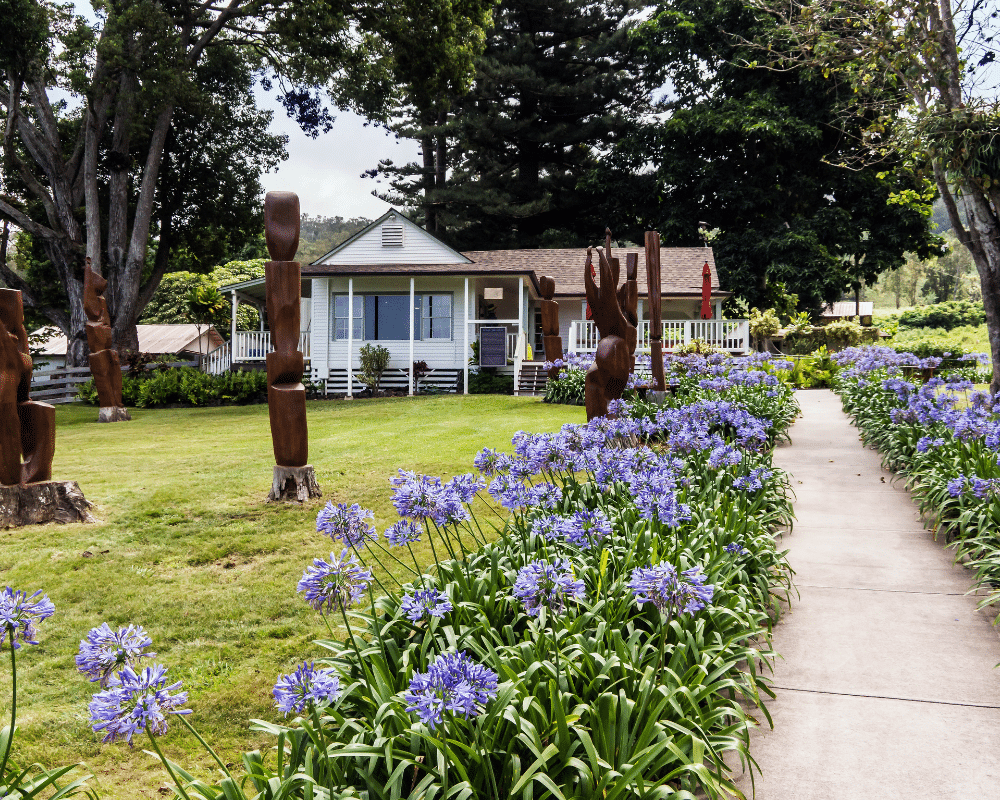
Originally found growing wild on roadsides in South Africa traders carried them home to every possible growing climate throughout the world. I read that you can follow the routes of trading ships from prior centuries by the agapanthus growing across the globe. We found these at a mountaintop ranch in Hawaii.
Companion Plants for Agapanthus
Good companions for agapanthus will share their requirements for excellent soil drainage and full to partial sun. Our goal is to complement the long stems and large globular flower heads. You can repeat the shape with plants such as allium, daylilies, and iris. You can complement the color with shades from the opposite side of the color wheel by seeking our yellow, orange, and vivid pink blooms. In addition, you can continue to raise the viewer’s eye upward by planting high-growing climbers such as Passion Vine, Wisteria or its tropical version the Queen’s Wreath

‘Agapanthus-How to Grow the Lily of the Nile’
‘How to Grow Dramatic Agapanthus in Containers and Pots.’
Blue Flag Iris-Iris virginica
Iris is harder to find in warm climates than in cool ones, and when we get a winner, we stay with it! The elegant blue flag iris is native to Florida. This one is for you if your garden has a low spot or a waters’-edge planting location. In the absence of a waterside planting area, keep the blue flag iris well-watered. This cold-hardy iris will grow throughout Florida.
We grow the blue flag iris pondside in our backyard. The planting location ranges from underwater to dry at various times of the year, and the plants thrive. In springtime in South Florida, the blossoms glow against the water. They are a beautiful sight.
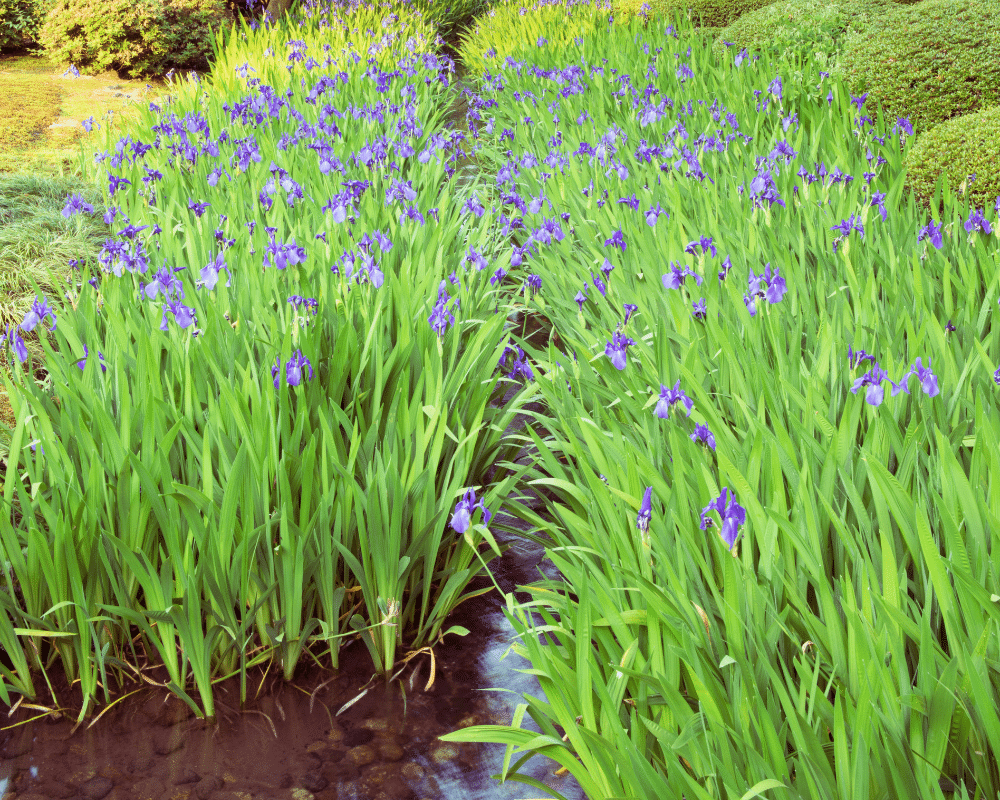
This is the Florida native Blue Flag Iris, reaching four feet tall, this is the only large iris native to Florida. Ranging from shades of blue to purple with a bright yellow throat they are something to anticipate with pleasure as every spring approaches!
While the flowers are limited to springtime; for the rest of the year the plant provides tall sword-like blue-green foliage reaching four feet in height. It provides a beautiful background for other plants.
Companion Plants for Florida Blue Flag Iris
We use our blue flag iris on the littoral shelf of a typical Florida freshwater pond. Directly upland from the shelf the soil is drier and we have used various ornamental grasses (lower in height, Liriope is a good choice, and sun-loving annuals or lower perennials such as the dwarf yellow Allamanda work as well. You can repeat the blue with salvia or add a mounding annual in another color.

Blue Salvia-Salvia officinalis
If I wanted serene shades of blue in my garden, all year and at low cost, I would include salvia. There are many varieties of salvia, both annual and perennial, and the perennial versions have among the longest blooming cycles of any perennials. This is an important feature for a plant especially if you want to see blue all year! (The annual versions, of course, bloom for their entire lifetimes.) Salvia is available in many colors, and blue and purple varieties are widely available.
Shades of Blue
Salvia will provide many shades of blue for your garden. I checked an online dealer who offers 120 blue salvia and 102 purple varieties. You should have plenty of choices.

For more information on salvia. ‘Ornamental Salvia’
Companion Plants for Ornamental Salvia
The elongated spires of Salvia are recommended as a companion to place in front of more dramatic plants such as roses or iris. Salvia are relatively drought tolerant, nectar-rich pollinator attractors and are available in various heights and colors, and will grow successfully with other plants with similar needs. Decide what shapes you need from companion plants and depending on your location consider other spire-shaped plants such as angelonia and lavender or various annuals to add more mounding shapes.
Persian Shield Strobilanthes dyerianus
A pretty plant is always valued in the garden but if you have a place for something truly striking in your garden consider Persian Shield. The plant is best known for its shimmering, iridescent purple leaves with a hint of silver gloss. Even better, as a foliage plant, the appearance is available all day. There is no bloom period, the plant glows all day!
A mounding, dense long long-leafed tropical perennial it is considered an annual north of zone 10. (In Zones 9-8 it should be root hardy, with the plant dying back after a freeze.)
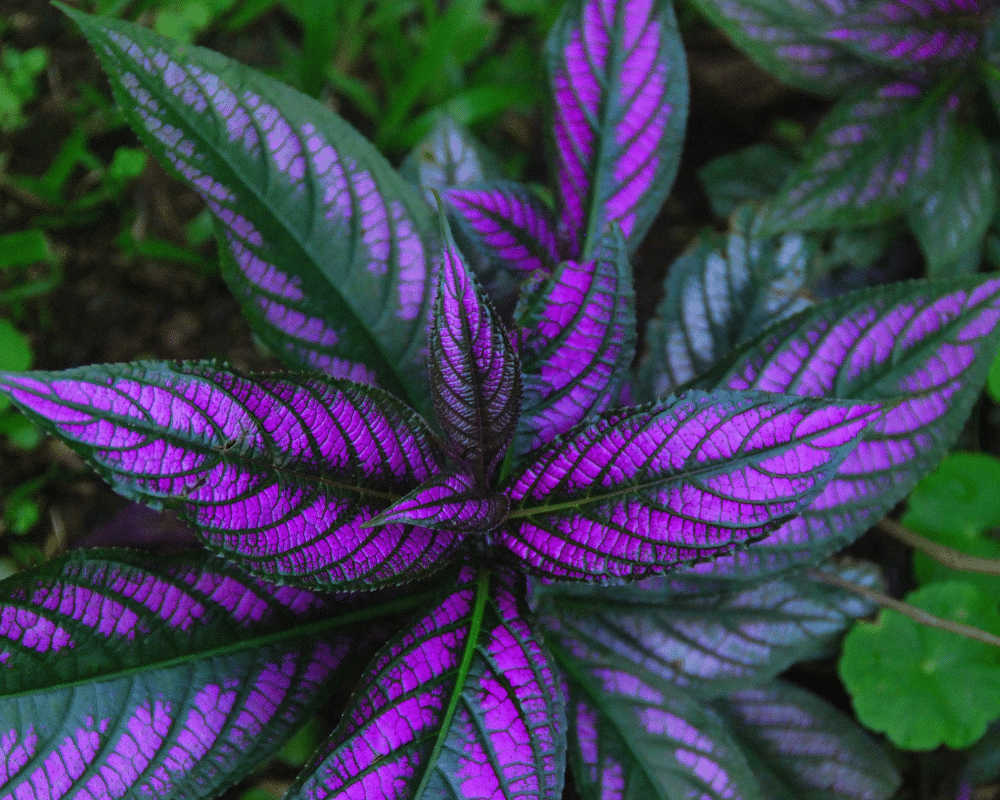
Persian shield was discovered in Myanmar (Burma) where its environment is warm and humid. To grow the plant successfully, try to duplicate those conditions as closely as possible. Persian shield performs best in bright indirect light.
You can grow this plant as a perennial in its hardiness Zone, as an annual, or as a house plant.
Companion Plants for Persian Shield
Some other plants that share the same growing conditions include Curcuma, which blooms in summer in large blooms with bright colors. Consider the following plants with good color choices, such as Impatiens, Lobelia, or Gardenia.
Blue Daze Evolvulus glomeratus
For brilliant sky blue flowers, and lots of them on a low-growing mounding plant; blue daze, a relative of the morning glory is a perfect fit. It is a sun and heat-loving, tropical perennial grown in most places as an easy-going annual. As the plant grows in a low, mounding form, it makes a desirable ground cover or border and edging plant. Consider the plant hardy in Zones 9-11. In our Zone 10 garden we find Blue Daze a very pleasant and versatile addition, however, the rabbits also agree! For that reason, we grow it in containers, raised beds, and hanging baskets. Try Blue Daze for hanging baskets and containers, the plant’s dense mounding shape rises above the container and trails attractively over the side.
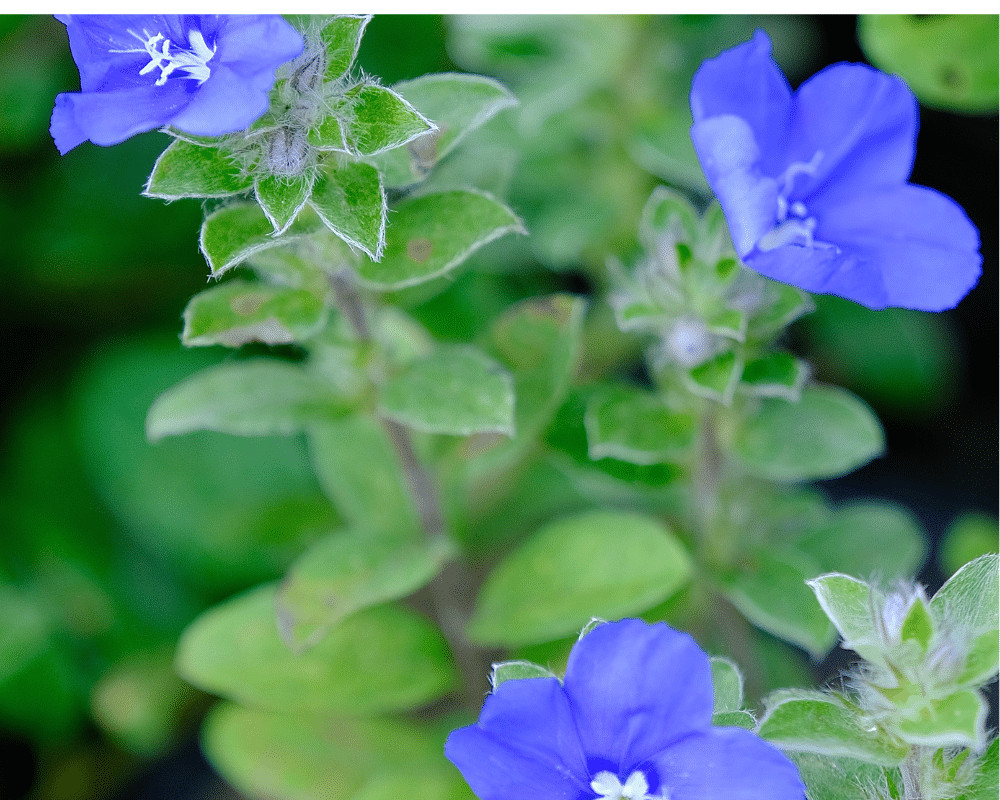
The Blue Daze plant offers two color benefits in the garden. The blue blossom is bright and clear and the foliage is small, dense, and in a soft gray-green color. This is set off well with dark shades of green and it also is attractive with silver plants.
Companion Plants for Blue Daze
Blue Daze has a long blooming season, however, they can become leggy late in the season and you may want to trim them back. Something that will provide late summer color will be helpful. Consider annual Dianthus, French Marigold, or Bacopa.
Pentas Pentas lanceolata
The popular Pentas plant, available in shades of purple and lavender is advertised as perennial in Zones 10-11. We have found them to live for several years in a prior Zone 9b garden, also. The regular Pentas grows from 18′-36″ in the regular form and there is a lower-growing dwarf form available.
Each flower head is made up of many tiny star-like blossoms and all will bring pollinators to your garden.
Companion Plants for Pentas
Pentas is comfortable with considerable amounts of sun and heat. Other plants that share these features include Portulaca, Verbena, Lantana, and Angelona. These choices will provide you with a variety of shapes and colors to add interest to your beds and containers.
Some Serene Garden Blue Blooms-Using Annual Flowers
Don’t overlook annual flowers as a way to get cool blues and violets in the garden on a seasonal basis. We know that some tropical perennials will grow for several years in South Florida. Others will not survive the summers of the south but are useful summer color sources in Central and North Florida and in the winter in southern regions. Here are some choices to consider.
Shades of Blue For A Serene Florida Tropical Garden
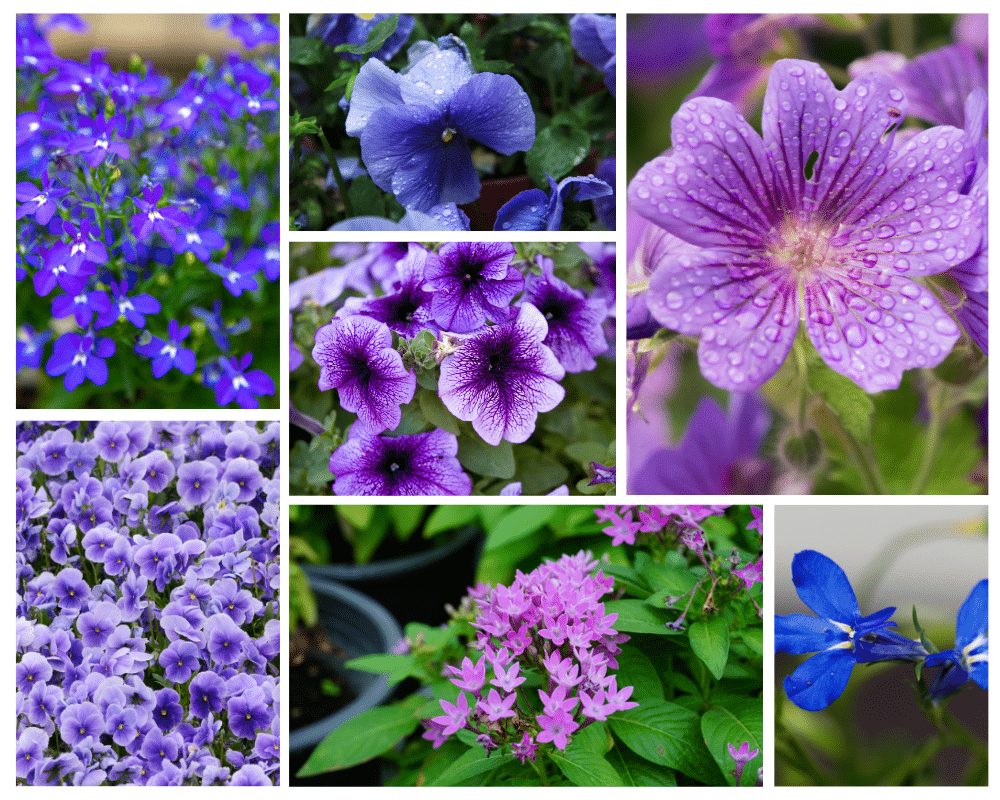
Some of these plants will provide true blue shades such as Lobelia and others will be in the purple and lavender range including geraniums and annual vinca. Even more such as Petunia and some of the much newer Petchoa will provide a range of shades. Pansies and Violas are alternatives too, although with shorter seasons, except in North Florida.
Resources for Growing Flowers in Florida
‘How to Grow a Blooming Florida Tropical Garden‘-this discusses using Annuals for color coverage.
‘Annual Bedding Plants’-with links to specific annual flowers.
‘Gardening With Annuals in Florida’-from the University of Florida with tables showing salt tolerance and anticipated bloom times for various part of Florida.
‘Our Best Gardening and Landscape Tips for New Floridians.’
